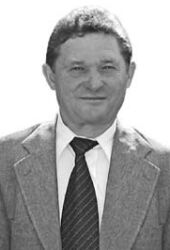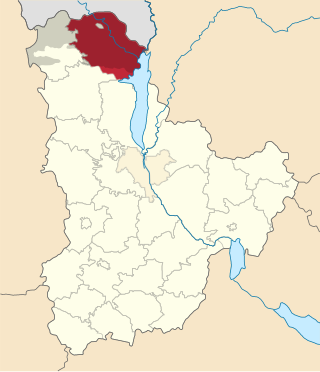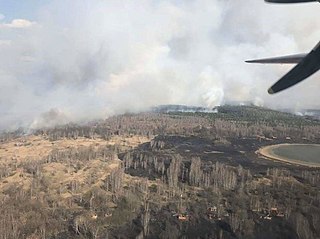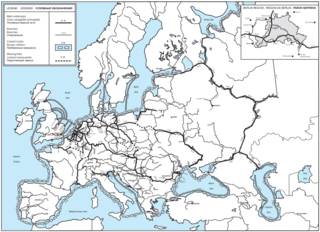
Chernobyl or Chornobyl is a partially abandoned city in the Chernobyl Exclusion Zone, situated in the Vyshhorod Raion of northern Kyiv Oblast, Ukraine. Chernobyl is about 90 kilometres (60 mi) north of Kyiv, and 160 kilometres (100 mi) southwest of the Belarusian city of Gomel. Before its evacuation, the city had about 14,000 residents. While living anywhere within the Chernobyl Exclusion Zone is technically illegal today, authorities tolerate those who choose to live within some of the less irradiated areas, and an estimated 150 people live in Chernobyl in 2020.

Pripyat, also known as Prypiat, is a mostly abandoned city in northern Ukraine, located near the border with Belarus. Named after the nearby river, Pripyat, it was founded on 4 February 1970 as the ninth atomgrad to serve the nearby Chernobyl Nuclear Power Plant, which is located in the adjacent abandoned Chernobyl. Pripyat was officially proclaimed a city in 1979 and had grown to a population of 49,360 by the time it was evacuated on the afternoon of 27 April 1986, one day after the Chernobyl disaster.

The Chernobyl Nuclear Power Plant Zone of Alienation, also called the 30-Kilometre Zone or simply The Zone, was established shortly after the 1986 Chernobyl disaster in the Ukrainian SSR of the Soviet Union.

The Chernobyl Nuclear Power Plant (ChNPP) is a nuclear power plant undergoing decommissioning. ChNPP is located near the abandoned city of Pripyat in northern Ukraine, 16.5 kilometers (10 mi) northwest of the city of Chernobyl, 16 kilometers (10 mi) from the Belarus–Ukraine border, and about 100 kilometers (62 mi) north of Kyiv. The plant was cooled by an engineered pond, fed by the Pripyat River about 5 kilometers (3 mi) northwest from its juncture with the Dnieper River.

Duga was an over-the-horizon radar (OTH) system used in the Soviet Union as part of its early-warning radar network for missile defense. It operated from July 1976 to December 1989. Two operational duga radars were deployed, with one near Chernobyl and Liubech in the Ukrainian SSR, and the other in eastern Siberia.

The Chernobyl disaster began on 26 April 1986 with the explosion of the No. 4 reactor of the Chernobyl Nuclear Power Plant near the city of Pripyat in northern Ukraine, near the Belarus border in the Soviet Union. It is one of only two nuclear energy accidents rated at the maximum severity on the International Nuclear Event Scale, the other being the 2011 Fukushima nuclear accident. The response involved more than 500,000 personnel and cost an estimated 18 billion rubles. It remains the worst nuclear disaster in history, and the costliest disaster in human history, with an estimated cost of $700 billion USD.

The Chernobyl disaster is the world's worst nuclear accident to date.

Leonid Petrovych Telyatnikov was a Soviet, and later Ukrainian, fire brigade commander notable for his role in directing the early stages initial response to the Chernobyl disaster. Telyatnikov served many years as an officer in both Soviet and Ukrainian firefighting organizations, working in a variety of junior and senior leadership positions throughout his career.
Chernobyl Recovery and Development Programme (CRDP) is developed by the United Nations Development Programme and aims at ensuring return to normal life as a realistic prospect for people living in regions affected by Chernobyl disaster. The Programme provides continuing support to the Government of Ukraine for elaboration and implementation of development-oriented solutions for the regions. The CRDP, part of the United Nations Development Programme activities in Ukraine, has been launched based on the recommendations of “The Human Consequences of the Chernobyl Nuclear Accident. A strategy for Recovery”Archived 2011-10-04 at the Wayback Machine, the joint report by UN agencies initiated in February 2002. Since 2003 the CRDP is constantly working to mitigate long-term social, economic and environmental consequences of the Chernobyl catastrophe, to create more favorable living conditions and to promote sustainable human development in the Chernobyl-affected regions. In partnerships with international organizations, oblast, rayon and state administrations, village councils, scientific institutions, non-governmental organizations and private business, CRDP supports community organizations and helps them to implement their initiatives on economic, social development and environmental recovery. In addition, the CRDP distributes information about the Chernobyl catastrophe internationally and within Ukraine.

The Ukrainian National Chernobyl Museum is a history museum in Kyiv, Ukraine, dedicated to the 1986 Chernobyl disaster and its consequences. It houses an extensive collection of visual media, artifacts, scale models, and other items. The museum is designed to educate the public about the many aspects of the disaster. Several exhibits depict the technical progression of the accident. There is also many areas dedicated to the loss of life and cultural ramifications of the disaster.

The Pripyat amusement park is an abandoned amusement park located in Pripyat, Ukraine. It was to have its grand opening on 1 May 1986, in time for the May Day celebrations, but these plans were cancelled on 26 April, when the Chernobyl disaster occurred a few kilometers away. Several sources report that the park was opened for a short time on 27 April before the announcement to evacuate the city was made. These reports claim that the park was hurriedly opened to distract Pripyat residents from the unfolding disaster nearby. However, these claims remain largely unsubstantiated and unsupported. Pripyat residents have not been able to recall for sure if the park was opened following the disaster, but considering the lack of panic at the time of the disaster and subsequent evacuation, there would seem to be no need to distract people. In any case, the park—and its ferris wheel in particular—have become a symbol of the Chernobyl disaster.

S.T.A.L.K.E.R.: Call of Pripyat is a first-person shooter survival horror video game developed by GSC Game World for Microsoft Windows. It is the third main game released in the S.T.A.L.K.E.R. series of video games, following S.T.A.L.K.E.R.: Shadow of Chernobyl and S.T.A.L.K.E.R.: Clear Sky, with the game's narrative and events following the former. It was published in the CIS territories by GSC World Publishing in October 2009, before being released by Deep Silver and bitComposer Games in North America and the PAL region in February 2010.

Lyubov Makarivna Sirota is a Ukrainian poet, writer, playwright, journalist and translator. As a former inhabitant of the city of Pripyat and an eyewitness of the Chernobyl disaster, she has devoted a great part of her creative output to the 1986 catastrophe. She writes in both Ukrainian and Russian, and also translates from Ukrainian into Russian and vice versa. Her poems have been translated into many languages, including English.

The Chernobyl disaster, considered the worst nuclear disaster in history, occurred on 26 April 1986 at the Chernobyl Nuclear Power Plant in the Ukrainian Soviet Socialist Republic, then part of the Soviet Union, now in Ukraine. From 1986 onward, the total death toll of the disaster has lacked consensus; as peer-reviewed medical journal The Lancet and other sources have noted, it remains contested. There is consensus that a total of approximately 30 people died from immediate blast trauma and acute radiation syndrome (ARS) in the seconds to months after the disaster respectively, with 60 in total in the decades since, inclusive of later radiation induced cancer. However, there is considerable debate concerning the accurate number of projected deaths that have yet to occur due to the disaster's long-term health effects; long-term death estimates range from up to 4,000 for the most exposed people of Ukraine, Belarus, and Russia, to 16,000 cases in total for all those exposed on the entire continent of Europe, with figures as high as 60,000 when including the relatively minor effects around the globe. Such numbers are based on the heavily contested linear no-threshold model.

The Chernihiv–Ovruch railway is a partially electrified and partially operational single track railway line that stretches between the town of Ovruch and the city of Chernihiv, in northern Ukraine, passing through southern Belarus and the Chernobyl Exclusion Zone. The line is owned by Ukrzaliznytsia alone, with railway stations located in Belarus being leased from the government of Belarus. A portion of the line between railway stations Vilcha and Semykhody has not been in service since the Chernobyl disaster, on 26 April 1986.

Chernobyl Raion or Chornobyl Raion was a raion in the Soviet Union located in the Ukrainian Soviet Socialist Republic. It was one of 26 administrative raions (districts) of Kyiv Oblast in northern Ukraine. After the Chernobyl disaster, the majority of the raion was contaminated, and many of its populated places were included into the Chernobyl Exclusion Zone, which is an officially designated exclusion area around the site of the disaster.

The 2020 Chernobyl Exclusion Zone wildfires were a series of wildfires that began burning inside Ukraine's Chernobyl Exclusion Zone in April 2020. The fires were largely extinguished within two weeks. At least one suspect was arrested for alleged arson.

Waterway E40 is a planned navigable transport route that aims to connect the Baltic Sea and the Black Sea.

During the Russian invasion of Ukraine, the Chernobyl Exclusion Zone was captured on 24 February, the first day of the invasion, by the Russian Armed Forces, who entered Ukrainian territory from neighbouring Belarus and seized the entire area of the Chernobyl Nuclear Power Plant by the end of that day. On 7 March, it was reported that around 300 people were trapped and had been unable to leave the power plant since its capture. On 31 March, it was reported that most of the Russian troops occupying the area had withdrawn, as the Russian military abandoned the Kyiv offensive to focus on operations in Eastern Ukraine.

















